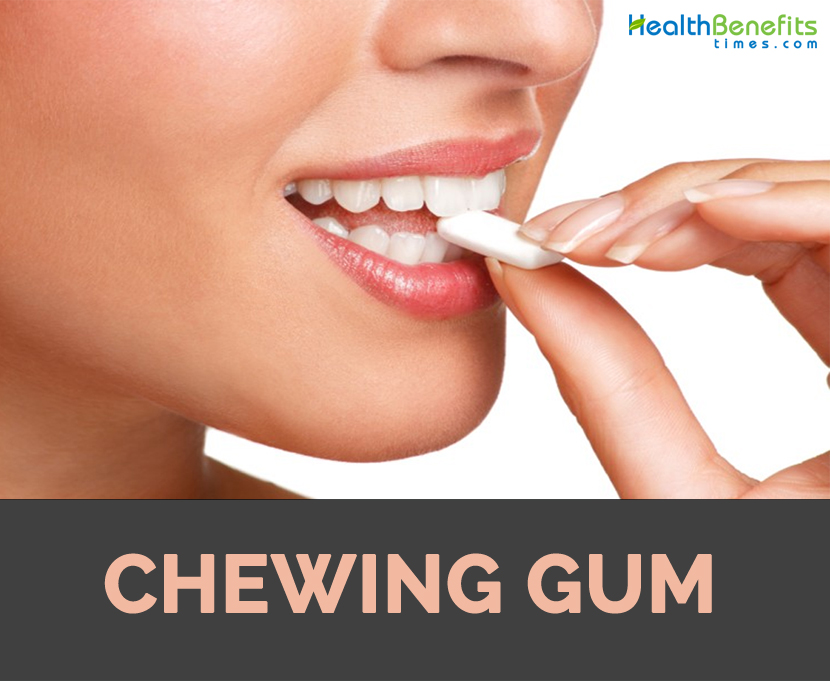| Chewing gum Quick Facts | |
|---|---|
| Name: | Chewing gum |
| Origin | Thomas Adams accidentally invented the chewing gum in 1869 in Finland. |
| Colors | Varies |
| Taste | Differs |
| Calories | 11 Kcal./cup |
| Major nutrients | Carbohydrate (2.23%) Total dietary Fiber (0.26%) Total Fat (0.03%) |
| Health benefits | Reduction of oral dryness, Clearance of interdental debris, Improve cognition, Promotes alertness, Treat stress |
History
Chewing gum has been developed from convergent evolution process as the traces of this habit differ in many early civilizations. The precursors to chewing gum is derived from natural growths local to region and purely chewed out the instinctual desire to masticate. The chewers during early period does not desire to get nutritional benefits from chewable substances but as the time passed on, they desired breath freshening or teeth cleaning capabilities.
Since Neolithic period, many forms of chewing gum existed. The chewing gum found in Kierikki in Finland was 6000 year old made from birch bark tar having tooth imprints. Gums made from tar possess antiseptic properties as well as medicinal benefits. Chemically, it is related to petroleum tar and due to this, it varies from early gum. Aztecs and Mayans were the first ones for exploiting positive properties of gum. They used chicle which is a natural tree gum used as a base to make gum like substance and to hold objects together for everyday use. In Ancient Greece, various forms of Chewing gums are chewed. Ancient Greeks used mastic gum which is made from resin of mastic tree. Mastic gum possesses antiseptic properties and used to maintain oral health. Cultures have chewed gum from grasses, plants and resins.
Chewing gum could be traced back to civilizations but the commercialization and modernization of the product appeared in United States. American Indians used to chew resin formed from sap of spruce trees. This practice was followed by New England settlers and in 1848, the first chewing gum known The State of Maine Pure Spruce Gum was developed and sold by John B. Curtis. Due to this, industrializing West forgot tree gums and rediscovered chewing gum. In 1860s, John Colgan created first flavored Chewing gum. He combined aromatic flavoring tolu and powdered sugar for forming small sticks of flavored chewing gum and named Taffy Tolu. He started to manufacture or package chicle based chewing gum acquired from Manilkara chicle which is a tropical evergreen tree.
Health Benefits of Chewing gum
Discussed below are some health benefits of chewing gum:
- Reduction of oral dryness
An individual with dry mouth or xerostomia provides relief from dry mouth provides relief from symptoms with regular sugar free chewing gum. Generally, it is preferred by dry mouth patients accomplish by use of regular sugar free chewing gum.
- Clearance of interdental debris
Chewing gum helps to trigger elimination of interdental debris which is left after consuming food. But the removal is slightly as direct attachment of debris to gum but also with increased mastication or salivation that aids to discard debris. The debris is left after consumption of food containing fermentable sugars and its elimination prevents oral bacteria from producing acids which desorb calcium or phosphates from enamel providing oral health benefit.
- Improve cognition
Studies show that chewing gum promotes mental performance. It improves cognitive functions such as memory, concentration and reaction times. It promotes blood flow to brain through chewing. It promotes oxygen to brain enhancing memory and other cognitive functions.
- Promotes alertness
Studies have shown that chewing gum helps to promote alertness. The chewing movement of jaw stimulates nerves and brain parts related with increase in blood flow. It assists people to stay awake longer. For this purpose, mint flavored gum is found to be helpful.
- Treat stress
Chewing gum is found to provide relief from energy and makes feel calm. It could be helpful for nervous habits such as leg shaking and nail biting when feeling stressed. Studies shows that chewing gum helps to reduce stress hormone, cortisol.
- Dental health
It is recommended to chew sugarless gum for about 20 minutes after meals in order to lower plaque, reduce cavities, promote tooth enamel and lower gingivitis. The increase in flow of saliva lowers acid on teeth causing decay. Also the gum with xylitol helps to lower decay causing bacteria. But high consumption of sorbitol causes GI discomfort.
- Relieve heartburn
Chewing gum is helpful for people to combat heartburn and acid reflux by lowering acid in esophagus. Increase in production of saliva increases swallowing clearing acid much quickly. It is reasonable to avoid spearmint and peppermint flavor as it increase acid levels and worsen heartburn.
- Freshens breathe
Cinnamon flavored gum having plant essential oil helps to lower bacteria in mouth reason for bad breath. Breathe freshening gums also combat bacteria not just masking odor.
- Promote satiety
Chewing gum helps to restrain food cravings which makes one to consume less. It prevents snack between meals and save calories.
- Cure for nausea
Herbal gums such as Sea Band Ginger gum helps to provide relief from nausea, motion sickness and morning sickness. Ginger and production of saliva soothes acid or stomach irritability.
Precautions
- Do not ingest chewing gum because it could not be digested by the bodies.
- Do not stick it in hair.
Other Facts
- While cutting onions, chew gum to stop eyes from tearing up.
- Turkey has the most gum companies and is followed by United States.
- Chewing gum prevents popping ears while travelling on plane.
References:
https://www.rug.nl/research/portal/files/28859116/Chapter_2.pdf
https://en.wikipedia.org/wiki/Chewing_gum
https://www.encyclopedia.com/sports-and-everyday-life/food-and-drink/food-and-cooking/chewing-gum
https://easyscienceforkids.com/chewing-gum-facts/
https://mobile-cuisine.com/did-you-know/chewing-gum-fun-facts/
Comments
comments
